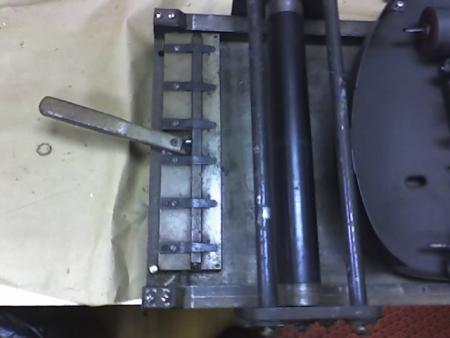gripper bar for a Nolan
Hi,
this is a gripper bar assembly for a Nolan proof press. Has anyone seen or have one they’d like to get rid of? I have a Nolan and this would be a great addition to it, but I’d never seen one before this. This example is at the Center for Book and Paper Art in Chicago.
patrick
[email protected]

10-14-08_2017.jpg

10-14-08_2018.jpg
We’re wondering if anyone ever located a gripper bar for a Nolan?
We’re wondering if anyone ever located a gripper bar for a Nolan?
Never did, sorry.
Hi,
I have a line-o-scribe press which has a device similar to what you’re looking for. It’s of limited use because your margins aren’t always that wide and you have to position your form in relation to it which isn’t always convenient and it can leave a mark on the paper. I’ve been working out a way to register on the bed using something you lock up with your form. I just tried it out on my line-o-scribe and also my Poco proof press and it works well. I use a 1 1/2” piano hinge cut down to the length of my press bed or less. Then using very short bolts and nuts I attach a piece of .060 binder board by drilling holes and attaching. I think the “bolts” I used are called posts (3/16”) and come with a matching part which I discarded in favor of a regular nut. It really only takes two or three to hold the board absolutely rigidly in place. Then I lock the piano hinge side that is loose up in the bed of the press along with my printing form and run it through the press. This leaves an impression on the board where the printing will be. Then I cut out just where the printing areas will be, based on this impression. This leaves a window. Now I have a sort of frame onto which I can place any sort of device to hold the paper in the right position. I’ve been using strips of binder board and making a corner and a long side guide which I glue stick in place. I suppose you could tape on a traditional quad guide or magill guide. I do have a mat cutter which makes it easy to cut the binder board. Binder board is cheap so I plan to reuse when I can and just make a new one when I need to. I made up several with hinges attached to sit in waiting. I plan to photograph and post this on my Poco stops thread elsewhere on Briar Press.
ps. you probably could just tape a piece of matboard onto a piano hinge. The main thing is that it not shift around at all.
I also own a (#2) Nolan and have been trying to devise a reliable registration system that will work with the largest form size (I’m greedy) — my first experiment is a homemade paper-trapping ‘gripper bar’ made of plywood and spring steel bulldog clamps (pictures below). It works pretty well, but would benefit from side guides (I use my eye, and the sides of the bed). I’ve been trying to devise a DIY registration pin system, as I think it would be more labour intensive, but more accurate.
IMG_1872.jpg
IMG_1867.jpg
IMG_1866.jpg
Very clever! Did you attach a strip of metal to the jaws of the bulldogs—I thought that’s what I was seeing? Would love to hear about your experience with a pin system…
A very late response! I have finally got around to trying a DIY pin system on my press — fairly successful, though side guides would be a great help.
Notes on the attached images:
Punching Jig:
This is the simple jig I’m using to punch the paper — it uses the same model of paper punch as I’m using for the pin bar, mounted on plywood with a simple grid for paper positioning. I may have to add 1/2” or 1/4” grid lines in the future, but this works fine for me for now.
Paper hung on the pins
This view shows the paper on the pin bar. Unfortunately the ‘pins’ are the ‘punches’, and the ‘punches’ are tapered, so while it works surprisingly well, there is some play in the paper to be careful of. My next experiment will be to make a pin bar using commercial registration pins mounted on furniture. The commercial pins don’t taper.
Pin Bar
This view shows the ‘pin bar’ which is made from an identical 3-hole punch to the one used for the punching jig. The mechanical mechanism of the 3-hole punch is glued to a low strip of plywood furniture. the reason for the very low furniture in front of the ‘pin bar’ is that the bar has a lip I haven’t filed off (I thought it might help with paper feeding, but it isn’t at all necessary).
Full view of press with block
View of the press (Nolan Proof Press #2) with registration pin bar and block.
This registration system is based on the method described here
Punching jig
Paper hung on the pins
Pin Bar
Full view of press with block